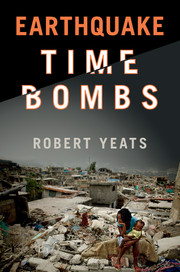Book contents
- Frontmatter
- Contents
- Acknowledgments
- Why this book?
- PART I EARTHQUAKES, DEEP TIME, AND THE POPULATION EXPLOSION
- 1 Plate tectonics and why we have earthquakes
- 2 An earthquake primer
- 3 Deep time
- 4 When's the next Big One?
- 5 Population explosion and increased earthquake risk to megacities
- PART II EARTHQUAKE TIME BOMBS
- PART III SUMMARY AND RECOMMENDATIONS
- References
- Index
4 - When's the next Big One?
from PART I - EARTHQUAKES, DEEP TIME, AND THE POPULATION EXPLOSION
Published online by Cambridge University Press: 05 November 2015
- Frontmatter
- Contents
- Acknowledgments
- Why this book?
- PART I EARTHQUAKES, DEEP TIME, AND THE POPULATION EXPLOSION
- 1 Plate tectonics and why we have earthquakes
- 2 An earthquake primer
- 3 Deep time
- 4 When's the next Big One?
- 5 Population explosion and increased earthquake risk to megacities
- PART II EARTHQUAKE TIME BOMBS
- PART III SUMMARY AND RECOMMENDATIONS
- References
- Index
Summary
INTRODUCTION AND FRUSTRATION
As earthquake scientists, we study a natural phenomenon that could destroy a city and could kill tens of thousands of people. For that reason, we are frequently interviewed on television and radio to discuss earthquakes. Invariably, the first thing our interviewer wants to know is “When's the next Big One?” When our answer is “I don't know, exactly,” we frustrate our interviewer, who may start to lose interest. “You've been studying this problem for decades, and you still don't know?” But we are required to talk about identifying earthquakes in advance and say why we're not farther along in answering this question.
In our defense, it should be noted that it is difficult to predict anything. Will the stock market plunge us into a new recession like the one in 2008? Will we suffer a nuclear attack from North Korea? Will we suffer a drought next summer as bad as last summer? Each of these questions has its own army of prognosticators, so the earthquake people have lots of company.
The section on China (Chapter 12) describes the world's first successful earthquake “prediction” in Haicheng, Manchuria – an earthquake of magnitude 7.3 in February 1975. A year-and-a-half later, while the Chinese were still basking under the impression that they had figured out how to predict earthquakes, the nearby city of Tangshan was destroyed by an earthquake of magnitude 7.8, with the loss of more than 240,000 lives. The Haicheng earthquake had been preceded by foreshocks that had rattled the city and alerted its inhabitants to the danger, but the Tangshan earthquake had no foreshocks. It came as a complete surprise. Back to the drawing boards, not just the Chinese but all of us.
The US Geological Survey (USGS) thought it had a key to forecasting an earthquake on the San Andreas fault in a segment of the Coast Ranges of central California. This segment, at the tiny village of Parkfield, experienced moderate-sized earthquakes of magnitude 6 to 6.4 in 1857, 1881, 1901, 1922, 1934, and 1966, repeating every two to three decades.
- Type
- Chapter
- Information
- Earthquake Time Bombs , pp. 43 - 62Publisher: Cambridge University PressPrint publication year: 2015



